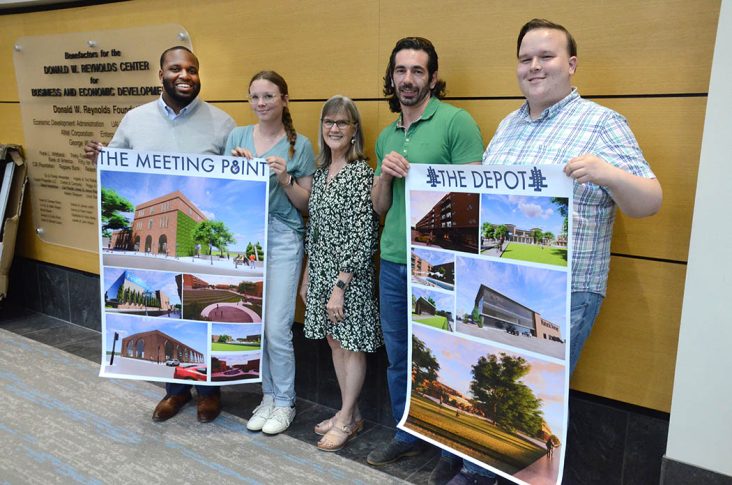Judges like UA-Little Rock students’ fix for St. Louis blight
by May 20, 2024 8:57 am 985 views

Pictured from left are team leader Lamar Townsend, Ashlin Graveline, instructor Elizabeth Small, and Adison Cummings.
What should a city do when a piece of riverfront property remains blighted and in need of redevelopment after an NFL team skipped town?
It might start by asking a team of University of Arkansas at Little Rock (UALR) real estate and finance students for their advice.
The team placed second among 17 schools April 13 in the Harold E. Eisenberg Foundation’s Real Estate Challenge. Among the other schools competing were Notre Dame, Auburn and Colorado. Judges were deadlocked between UALR and Tulane University after their presentations. They opted not to split the $7,500 scholarship prize and named Tulane the winner.
The students’ assignment was to create and present a redevelopment plan for a 21-acre blighted property site in St. Louis along the Mississippi River, about a mile from the St. Louis Arch and a mile from downtown.
The property was planned to be developed as the new home of the St. Louis Rams, but little has happened to it since the team announced it was moving to Los Angeles in 2016. At this point, the area is “pretty desolate,” said team member Osman Bagandov of Little Rock.
After receiving their assignment Jan. 24, students came up with a plan with a price tag of $189 million, which dropped to $179 million with brownfield tax credits. The team was required to own and develop the property for 10 years.
The Eisenberg Foundation is devoted to cancer research and real estate education. Its namesake, Harold Eisenberg, was a Chicago real estate developer who died of liver and pancreatic cancer at age 53. This was the competition’s 13th year.
UALR won the competition last year over 11 schools when students created a plan to redevelop the man-made Goose Island in Chicago. Two of this year’s students, team leader Lamar Townsend of Maumelle and Adison Cummings of Texarkana, were on that team and split the $5,000 scholarship with other team members.
This year’s other team member was Ashlin Graveline of Batesville, who like Townsend and Bagandov have graduated. Cummings will be a senior next year. The team was overseen by professor Elizabeth Small, UALR’s director of business networks and instructor of real estate development. It also was mentored by two Chicago-based real estate professionals: Siteng Ma, a graduate of Little Rock Central High, and Jenna Goebig. Ma’s parents previously worked at UALR.
The team’s plan called for renovating four of the five buildings standing on the site and left the other as is. They turned the historic Cotton Belt Building, a freight depot that is 780 feet long by 28 feet wide, into an apartment complex where all the apartments face the river. They offered the Peerless Building to Fritz’s Adventure out of Branson, which has ziplines, a ropes course and other activities.
Another building had high ceilings that made it an obvious candidate for a craft brewery, and indeed other teams included that in their design. Determined to do something unique, team members consulted with Origami Sake out of Hot Springs and included a sake rice brewery.
The team’s additions to the property included apartment buildings with retail space and a three-story, climate-controlled storage facility. Team members wanted all the apartment space to be above the river wall so all the tenants would be able to view the water.
The students created two separate areas separated by an amphitheater. One, The Meeting Point, focused on entertainment, while The Depot was geared toward housing, shopping and the storage facility. Graveline said the team’s slogan for The Depot was “Community, convenience, charm.” The team talked with Schnucks, a regional grocer, about operating a small store.
“The big idea is to really create what’s called the ‘third place,’” Townsend said. “So there’s this theory where you have your first place, which is your home; your second place, which is the place you work; and then people are really struggling to find that third place, which is community, and places to build community, build a place to enjoy themselves.
“And so the main idea with this is to build that third place where people can come and have a community and meet new people, shop, have entertainment opportunities, work out, all in one safe place, and also have opportunity to live and work in the same area as well.”
Several early ideas didn’t make the final cut because the team needed a 20% return on the property. A marina wouldn’t generate enough money, and the team couldn’t build on the river. Townhouses would not make as much money as apartments. Team members scaled back the underground parking because initial costs would be too high. Because of how diverse the site would be, they broke the financing out into three separate loans, dividing the risk.
“We had to just figure out what’s going to be profitable, what wasn’t, what we could keep and what wouldn’t work,” Bagandov said.
The students devoted many hours into the project despite the fact that they didn’t get a grade. Bagandov said he invested more time with this than he did his classes this semester. They stayed up until 2 a.m. the night before it was due and submitted it with only a minute to spare.
“I’ve never seen such dedication, and they remained calm. … I try not to put too much pressure on them, but I’ve told them over and over I do expect Broadway,” Small said with a laugh.
The students likewise credited Small, who was present for those meetings. Townsend recalled her staying up to help until 6 a.m. the previous year.
“We couldn’t do any of this without her,” Cummings said. “It’s wild the amount of people she knows. … Everyone has wonderful things to say about her.”
